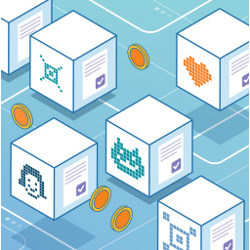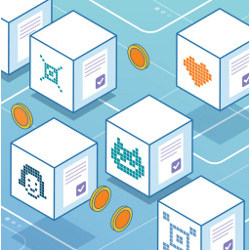
Behind Jeff Koons and David Hockney, the most lucrative auction for a piece of art from a living artist happened in 2021—and it was for a work that existed in a JPEG file. The artist Beeple’s “Everydays—The First 5,000 Days,” a series of digital artworks, sold at Christie’s for the princely sum of $69.3 million.
It was a stunning event made possible by a technology called non-fungible tokens (NFTs).
NFTs are cryptographic tokens built on the Ethereum blockchain. NFTs are “minted,” then sold, just like Bitcoin. The difference, though, is that Bitcoin is “fungible.” If you swap Bitcoin with someone, you both still have the same asset: some amount of Bitcoin. There’s no functional difference between one Bitcoin or another.
However, NFTs are “non-fungible.” Each token is unique, and that token proves that you, and only you, have ownership rights over a digital asset—like Beeple’s art. As a random Internet user, you can view Beeple’s “Everydays—The First 5,000 Days” online, but only the person who bought the NFT tied to the art owns it.
This dynamic creates a simple, but powerful, change in how digital art works: it makes digital art exclusive. Once minted on the Ethereum blockchain, the NFT is represented on a public ledger that can’t be changed. By owning the token, you are proven the owner of the art piece. There is nothing stopping someone online from viewing, copying, and sharing a digital art file, but thanks to NFTs, they cannot fake possession of the art. NFTs make it possible to have exclusive ownership of digital art—something that was previously impossible.
In some cases, artists like Beeple may structure the NFTs tied to their work in unique ways. They may retain rights to reproduce the image. They also may require automatic royalty payouts every time the NFT is resold.
Think of an NFT like the documents that come with owning an original Picasso. Art experts verify your Picasso is, in fact, original; they verify your ownership and provide documentation. As a result, the world accepts that you own an original Picasso.
The only big difference here is that NFTs make it possible to verify ownership of digital assets. Unquestionably there exist plenty of fraudulent Picassos, but given the limited supply of his works, and the legions of experts evaluating paintings, it is possible to prove that an individual owns a specific, legitimate Picasso.
It used to be impossible to do this for digital art. You could create digital art and everyone would know you made it, but anyone could reproduce it and share it with the entire world at the click of a button. In a scenario in which you can duplicate art with perfect fidelity indefinitely, the artist has some legal recourse to protect against how reproductions are used in commercial ventures. But who owns the original piece? What is the original piece? Is it the first file the artist created? Is it the first version of the finished piece?
Before NFTs, there was no widely accepted way to determine the “original” piece of a digital artwork. There was also no widely accepted way to prove or transfer its ownership. NFTs have changed that, and with it, they’re changing the world of art.
“We feel very confident that this is just the beginning for NFTs,” says Meghan Doyle, a cataloguer of post-war and contemporary art at auction house Christie’s. “There is tremendous potential for NFTs in the art market and beyond. As a mechanism, the potential that NFTs have to shift the way that we establish ownership has no bounds.”
A Better Way to Create
With this ability to mint ownership of digital assets, NFTs have transformed how artists and creators make a living while changing how we buy, sell, and relate to art. NFTs also have expanded interest in blockchain technology beyond investment in Bitcoin and Ethereum. Experts still debate whether NFTs are the future of art or just a fad, but the amount of money changing hands for art backed by NFTs has the art world, technologists, and financiers paying attention.
The biggest mainstream use of NFTs today is for artwork, thanks to Beeple’s big sale.
NFTs are so prevalent in art because digitally native creators can bestow scarcity on works that consist entirely of pixels, says Doyle at Christie’s. They enable creators to earn more than they would outside the restrictions of the fine art world. Today, creators typically only get paid when they initially sell a piece of artwork; should the artwork’s new owner sell it to someone else, they pocket any gains made—and the artist gets nothing. However, NFTs use smart contracts to verify ownership and terms. Those terms can include paying the original artist royalties every time the artwork changes hands.
“The smart contracts and royalties offer an attractive proposition to artists all over the world,” says Seyi Awotunde, who runs the 0pulence (www.0pulence.com) marketplace for art backed by NFTs.
Awotunde says he’s seeing artists demanding 10% royalties on resales become the market standard for NFTs. That gives artists the possibility of earning residual lifetime income from each piece of art they create. In turn, that means full-time artists can spend more time making art rather than working or freelancing to pay the bills.
“The reason why artists are interested in NFTs is that they’re easier, faster, more democratic, and far more appealing than the traditional art world model,” says Leighanne Murray, a contemporary art specialist who represents artists using NFTs.
She says artists are expected to go to art school, then work their way up the ladder. If they are lucky, they get noticed after years by a mid-tier gallery. From there, they are totally dependent on gallery directors to exhibit and sell their work. Only a select few ever reach the pinnacle of the pyramid.
Even if they do, success comes at a price. Art galleries often take a 50% commission on each sale, she says. Many have exclusivity contracts.
NFTs present an alternative. Any artist can mint an NFT for a piece of work. They set their own prices on easy-to-use online NFT marketplaces like OpenSea or Foundation. They control the promotion of their work through social media, and they keep all the earnings outside of basic transaction fees for selling an NFT.
For NFTs that pay royalties, the functionality is hard-coded into the smart contract on the blockchain. Once you set up the smart contract on the backend, royalties pay out automatically. There are no complicated payment platforms, invoicing, or logistics that artists need to manage.
There are benefits for collectors, too, says Chester Spatt, a finance professor at Carnegie Mellon University (CMU). Unlike physical art, it is easy to store and protect NFTs, since ownership is verified and secured on the blockchain. It also is simple to transfer an asset electronically between platforms and devices.
Uncertain Profits, Uncertain Future
There is no doubt NFTs are having a moment, but their long-term value is still unclear, says Deeksha Gupta, a finance professor at CMU.
While NFTs enable digital art ownership on the blockchain, digital art itself has not changed. Looking at a print of a physical painting is different from the experience of seeing the original. That is why almost everyone has seen a Mona Lisa reproduction at some point, but millions still travel to see the artwork in person.
“Since the experience of looking at the original cannot be replicated when looking at a [physical] print, the original should have greater value,” says Gupta. “This is not an argument that can be made with digital art because any print is identical to the original.” That calls into question how valuable NFTs actually are.
Bryan Routledge, a finance professor also at CMU, thinks the downsides of NFTs go beyond how we value art. The very way the tokens work could create problems. Setting up the smart contracts that deal with future royalties for artists is not always easy, he says. And they make it possible to design complicated ownership structures.
“Is that a good idea? That is not clear,” says Routledge. “Some of the initial prices an artist receives reflect future appreciation.” NFTs may bring sale prices down by enabling royalties. In expanding the overall financial pie for creators, they also may reduce the size of everyone’s slice.
The so-called “last mile” problem with blockchain is another issue, says Christian Catalini, a professor who studies blockchain at the Massachusetts Institute of Technology Sloan School of Management.
The last mile problem refers to how digital assets interact and interface with the offline world. For instance, you need a way to turn your offline money into Bitcoin. No matter how useful Bitcoin is from a technological perspective, the only way you can use it is with sites that act like on- and off-ramps that connect the offline world to the digital one. Bitcoin solves the problem by being sufficiently well-established that there are plenty of exchanges on which to transact in the cryptocurrency. There also is a vast, passionate segment of users.
“What gives value and makes some of these NFTs ‘useful’ in the long run critically depends on what their link to the offline world is,” says Catalini. “This link could be as simple as a community supporting their creation and exchange. If that community loses engagement, so does much of the value associated with NFTs.”
If NFTs overcome these challenges, they could transform art and technology as we know it. Murray predicts traditional art institutions and major galleries will come to accept NFTs. Awotunde believes the incentives align well enough that we shall see an NFT-backed artwork sell for over $100 million this year. Digital art itself is also getting its day in the sun thanks to NFTs, says Doyle at Christie’s.
“Before the introduction of NFTs and blockchain technology, it was impossible to assign value to works of purely digital means,” she says. “Digital art isn’t new; it’s only new to the traditional art market. And we are now seeing it make up for lost time.”
That’s to say nothing of the bump NFTs give to blockchain as a whole, says Catalini.
“NFTs will accelerate the growth of the cryptocurrency space outside of finance, and will bring novel ideas and approaches from new sets of creators, artists, collectors of digital items, developers and more.”
Clark, M.
NFTs, explained, The Verge, Mar. 2021, https://bit.ly/3ic4WkT
Nguyen, T.
The value of NFTs, explained by an expert, Vox, Mar. 2021 https://bit.ly/3ye5hJj
Tarmy, J.
Crypto Investor Moves On to Picasso After $69 Million Beeple NFT Miss, Bloomberg, Apr. 2021, https://bloom.bg/3A3LbCb





Join the Discussion (0)
Become a Member or Sign In to Post a Comment